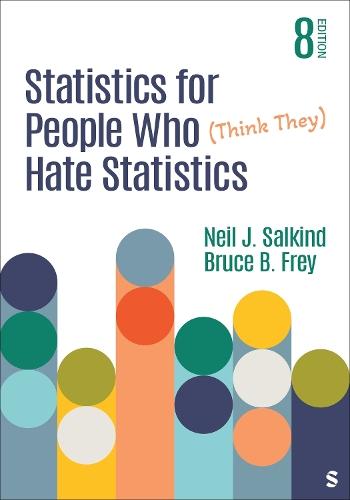Overview
The bestselling Statistics for People Who (Think They) Hate Statistics teaches an often intimidating and difficult subject in a way that is informative, personable, and clear. In the Eighth Edition, the authors take students through various statistical procedures, beginning with correlation and graphical representation of data and ending with inferential techniques and analysis of variance.
Full Product Details
Author: Neil J. Salkind ,
Bruce B. Frey
Publisher: SAGE Publications Inc
Imprint: SAGE Publications Inc
Edition: 8th Revised edition
Weight: 0.650kg
ISBN: 9781071855508
ISBN 10: 1071855506
Pages: 376
Publication Date: 14 November 2025
Audience:
College/higher education
,
Undergraduate
,
Postgraduate, Research & Scholarly
Format: Paperback
Publisher's Status: Forthcoming
Availability: Not yet available

This item is yet to be released. You can pre-order this item and we will dispatch it to you upon its release.
Reviews
Of all the statistics textbooks that I have reviewed, Statistics for People Who (Think They) Hate Statistics is by far the best. -- Brittany Landrum [Statistics for People Who (Think They) Hate Statistics] eases students into concepts with clear intention for each chapter and prompts them to connect everything they′ve learned. -- Russell Brandon Two of my favorite statistical authors being together in one book may be a dream come true. Both Salkind′s and Frey′s texts have been a survival manual both for me and for my students. There are very few texts that carry both the weight of statistical grandeur along with the depth of content like this new text does. This is a masterpiece of statistical reference data that meshes the best parts of both authors and fills in the gap following the passing of Salkind. I can′t wait to get this new text into the hands of my students, and I know that this new book is going to become a foundational pillar in all of my classes. -- Jesse Buchholz This book has a successful conversion mission. Indeed, it succeeds in converting statistics-shy students into statistics-savvy ardent learners. The re-appearance of this mind-catching treasure is a major plus in the effective teaching and easy learning of an introductory course in descriptive and inferential statistics. -- Abdol Abdollahy Zarandi Salkind and Frey have written an informative and comprehensive text for the introductory statistics course that is also funny and disarming. My graduate students —many of whom exhibit an initial wariness toward math courses and long-dormant math skills—have found it to be an unexpected pleasure and an accessible read. -- Diana Dansereau Many students appear unaware that they are using statistics and research methods in their daily lives. When I mention statistics in the research methods course, some get very anxious and remind me that they are not ""math people"". Statistics for People Who (Think They) Hate Statistics is a helpful supplemental text for a research methods course. It provides a different perspective regarding how statistics are used and helps students retrieve and build on their statistics knowledge. The text uses humor and interesting examples and helps illustrate why certain research issues are important. -- Adele Crudden I love the layout of the text and the detailed and straightforward explanations of many of the concepts that students often struggle to comprehend when it comes to statistics. The authors′ introduction of SPSS and their step-by-step instructions for its use was superior to any other texts that I considered. -- Craig Peck
Author Information
Neil J. Salkind received his PhD in human development from the University of Maryland, and after teaching for 35 years at the University of Kansas, he was Professor Emeritus in the Department of Psychology and Research in Education, where he collaborated with colleagues and work with students. His early interests were in the area of children’s cognitive development, and after research in the areas of cognitive style and (what was then known as) hyperactivity, he was a postdoctoral fellow at the University of North Carolina’s Bush Center for Child and Family Policy. His work then changed direction to focus on child and family policy, specifically the impact of alternative forms of public support on various child and family outcomes. He delivered more than 150 professional papers and presentations; written more than 100 trade and textbooks; and is the author of Statistics for People Who (Think They) Hate Statistics (SAGE), Theories of Human Development (SAGE), and Exploring Research (Prentice Hall). He has edited several encyclopedias, including the Encyclopedia of Human Development, the Encyclopedia of Measurement and Statistics, and the Encyclopedia of Research Design. He was editor of Child Development Abstracts and Bibliography for 13 years. He lived in Lawrence, Kansas, where he liked to read, swim with the River City Sharks, work as the proprietor and sole employee of big boy press, bake brownies (see www.statisticsforpeople.com for the recipe), and poke around old Volvos and old houses. Bruce B. Frey, PhD, is an award-winning researcher, author, teacher, and professor of educational psychology at the University of Kansas. He is the editor of The SAGE Encyclopedia of Educational Research, Measurement and Evaluation and the SAGE Encyclopedia of Educational Design. In addition to being the lead author for The Statistics for People Who (Think They) Hate Statistics series, his books for Sage include There’s a Stat for That!, and 100 Questions (and Answers) About Tests and Measurement. He also wrote Statistics Hacks for O’Reilly Media. In his spare time, Bruce leads a secret life as Professor Bubblegum, host of a YouTube channel and Echo Valley, a podcast that celebrates bubblegum pop music of the late 1960s. The show is wildly popular with the young people.



